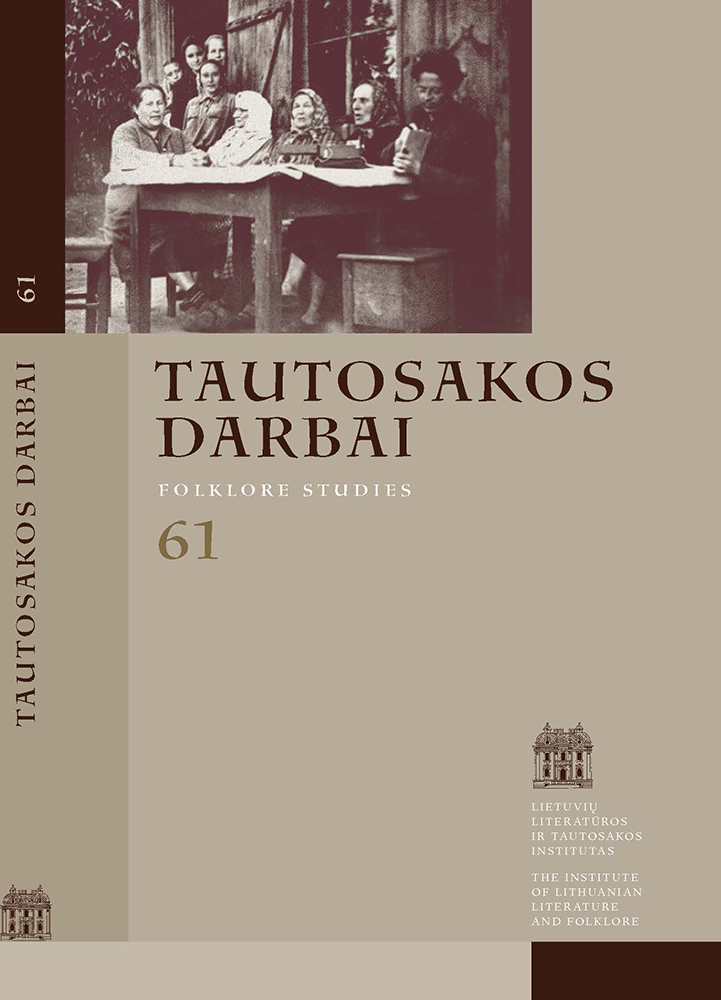Historical Narrative of American Lithuanian Identity
Abstract
The article looks into the unexplored problem of the expression of American Lithuanian identity through food. The author tries to reveal the main eating habits of Lithuanian emigrants by using comparative historical research of the narrative. Based on a theoretical approach of “change” perceived as a changing identity, food is seen as a distinctive part of culture that changes in the migration process. In her esearch, the author is going deep into the 20th century cookbooks published in America at different times and by different migration waves of Lithuanian migrants. These cookbooks reveal how the new culinary environment is accepted or rejected through food similarities or differences. The article deals with the problem of (non-)formation of American ethnic cuisine; analyzes how the food of Lithuanian diaspora changed during migration, how its choices were influenced by the multicultural American environment; what is the connection between American Lithuanian food and language; and whether Lithuanian food influenced the construction of national identity in the diaspora.
The analysis of the narrative of the cookbooks reveals that the multicultural American environment and the prevailing ideas of the “Melting Pot” and “Salad Bowl” theories conditioned the “change” in the emigrant kitchen. The ideas of the “Melting Pot” theory determined not only the addition of “American” and other nations’ dishes to Lithuanian cuisine, but also a certain “melting” process, during which dishes were flavored or their ingredients were replaced with non-Lithuanian cuisine. In the second half of the 20th century, when another “Salad Bowl” theory describing multicultural communities prevailed, Lithuanian emigrants turned to their cooking traditions inherited from their parents. This suggests that food and the traditions associated with its preparation, even when socio-cultural circumstances have changed, remain unchanged or little changed in people’s memory.
The analysis of the connection between language and food reveals that in America, when Lithuanians gradually take over the dominant English language, the gap between the knowledge of the mother tongue and the practice of Lithuanian food becomes more relevant. By no longer knowing or having poor Lithuanian language skills, the younger generation of emigrants does not lose the desire to prepare dishes prepared by parents and grandparents. This raises the need to memorize recipes for such dishes in English. This fact allows us to state that while living in the diaspora, Lithuanian food exists as an important expression of ethnic identity, regardless of the level of language proficiency, and the culinary heritage is more enduring than the atrophy of the Lithuanian language.
Finally, it becomes clear that in certain strata of the Lithuanian community there is an understanding that food and nutrition are important not only as meeting physical needs for the maintenance of vital functions. Nevertheless, it is also very important for the nation’s survival by deliberate food choice. Encouraging the production of Lithuanian dishes can become an opportunity to express a sense of ethnic self-awareness and strengthen the Lithuanian communities in the diaspora.
Downloads
Most read articles in this journal
- Oksana Kuzmenko, Russians in Ukrainian Folklore from the 20th and Early 21st Centuries: The Dynamics of the Images and Contexts , Tautosakos darbai: Vol. 64 (2022)
- Donata Mitaitė, Pranutė Aukštikalnytė-Jokimaitienė, One of the “Tragic Generation” , Tautosakos darbai: Vol. 65 (2023): Tautosakos darbai
- Jurgita Ūsaitytė, Song as a Propaganda Tool: Surveying the Soviet Time Songbooks , Tautosakos darbai: Vol. 65 (2023): Tautosakos darbai
- Aušra Kairaitytė-Užupė, Egidija Ramanauskaitė, The Emergence and Prevalence of Informal Youth Self-published Fanzines in Lithuania , Tautosakos darbai: Vol. 65 (2023): Tautosakos darbai
- Vita Ivanauskaitė - Šeibutienė, Dreams of Care and Consolation: Reflections of the Funeral Rites in the Dream Narratives , Tautosakos darbai: Vol. 63 (2022)
- Giedrė Raguotienė, Vilmantė Aleksienė, Jolita Zakarevičienė, Therapeutic Aspects of Traditional Music during Pregnancy, Childbirth and the Postpartum Period , Tautosakos darbai: Vol. 66 (2023): Tautosakos darbai
- Vytautas Budvytis, Jonas Basanavičius as Creator of the Thracian Theory of Lithuanian Origin , Tautosakos darbai: Vol. 62 (2021)
- Sandis Laime, Latvian Laumas: Reflections on the Witchisation of Tradition , Tautosakos darbai: Vol. 62 (2021)
- Saulius Pivoras, Lithuanian Proverbs as a Source of Natural Law Regulations in the Historical Writings of Simonas Daukantas , Tautosakos darbai: Vol. 66 (2023): Tautosakos darbai
- Skaidrė Urbonienė, “God-Maker” in Lithuanian Village of the End of the 19th – the First Half of the 20th Century: an Artist and / or a Craftsman , Tautosakos darbai: Vol. 53 (2017)




